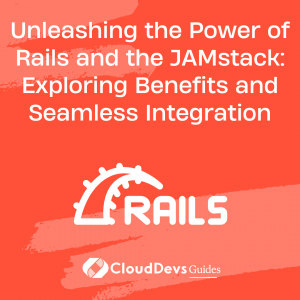Unleashing the Power of Rails and the JAMstack: Exploring Benefits and Seamless Integration
Table of Contents
Rails, known for its robustness and convention-over-configuration approach, has long been a preferred choice for building web applications. However, with the rise of the JAMstack architecture, developers are exploring new ways to combine the power of Rails with the benefits of a modern static site generator. In this blog post, we will dive into the world of Rails and the JAMstack, exploring the advantages of this integration and showcasing how to seamlessly incorporate Rails into a JAMstack workflow. We will cover topics such as static site generators, serverless functions, headless CMS, deployment strategies, and the overall benefits of building Rails applications with the JAMstack approach.
1. Understanding the JAMstack:
We start by providing an overview of the JAMstack architecture and its core principles. We discuss the decoupling of front-end and back-end, the use of static site generators, the reliance on APIs and serverless functions, and the benefits of improved performance, scalability, and security.
2. Leveraging Static Site Generators:
We explore popular static site generators such as Jekyll, Hugo, and Gatsby, and discuss how they fit into the JAMstack workflow. We showcase the benefits of pre-rendering content, optimized performance, and ease of deployment that static site generators offer.
3. Incorporating Rails in the JAMstack:
We delve into the integration of Rails within the JAMstack architecture. We discuss various approaches for incorporating Rails into the workflow, including using it as a headless CMS, as a backend API for data retrieval, or as a serverless function for handling dynamic functionality.
4. Building API Endpoints with Rails:
We explore the process of building Rails APIs that serve as data sources for JAMstack applications. We discuss best practices for designing and developing RESTful APIs, including authentication, versioning, and serialization techniques. We showcase how to expose data from Rails to be consumed by static site generators.
5. Headless CMS Integration:
We discuss the integration of headless CMS solutions with Rails and the JAMstack. We explore popular CMS options such as Contentful, Strapi, or GraphCMS, and showcase how to leverage their APIs to manage content within a Rails application and retrieve that content in a JAMstack workflow.
6. Serverless Functions with Rails:
We delve into the usage of serverless functions with Rails in a JAMstack context. We discuss the benefits of serverless architecture for handling dynamic functionality and demonstrate how to implement serverless functions using frameworks like AWS Lambda or Google Cloud Functions.
7. Deployment Strategies:
We explore deployment strategies for Rails applications in the JAMstack. We discuss options such as deploying the Rails backend separately from the static frontend, utilizing CDN for static assets, and leveraging services like Netlify or Vercel for deploying JAMstack applications. We cover techniques for achieving continuous deployment and automating the deployment process.
8. Benefits and Considerations:
We discuss the benefits of combining Rails and the JAMstack, including improved performance, scalability, security, and development speed. We also address considerations such as data synchronization, caching, and handling real-time updates in a JAMstack architecture.
9. Conclusion:
By combining the power of Rails with the JAMstack, developers can leverage the strengths of both approaches to build high-performing and scalable web applications. We explored the benefits of this integration, incorporating Rails as a headless CMS, building API endpoints, and utilizing serverless functions. We also discussed deployment strategies and considerations when adopting the JAMstack architecture.
With this knowledge, you can confidently embrace the Rails and JAMstack combination, enabling you to build modern, fast, and scalable applications that provide an exceptional user experience



